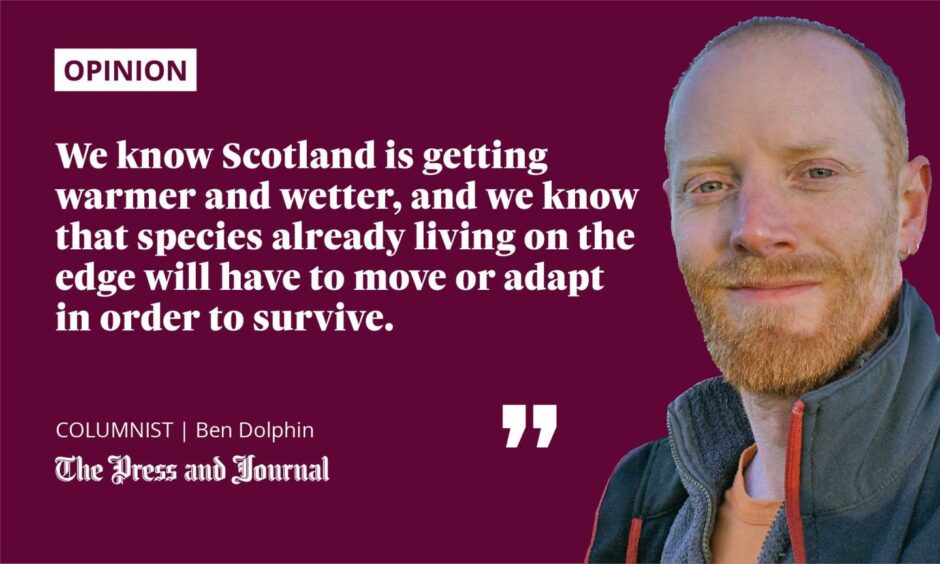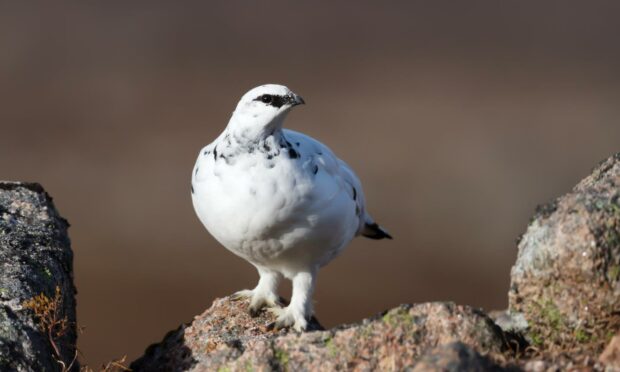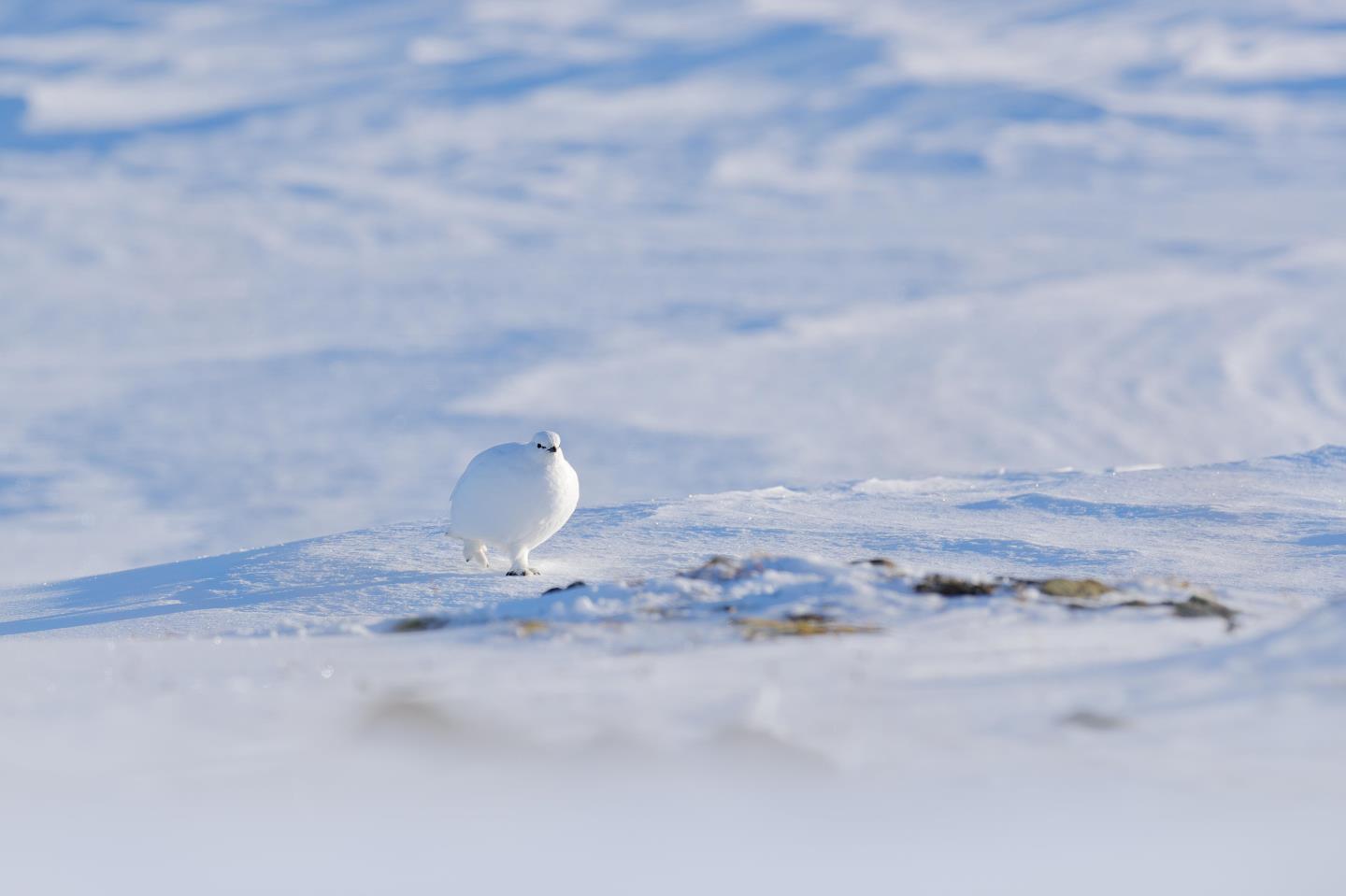The summit’s not far off, but I pause my ascent, just to soak up the atmosphere.
I’m 800 metres up a hill in November, but there’s nothing moving. Nothing at all. Not even the grass. The air’s so still that all I can hear is my faint tinnitus. Just a few weeks ago, you’d have heard the cheerful chirping of meadow pipits, but they’ve all migrated away. It’s ridiculously quiet.

The world’s only sound, when it comes, stands out a mile. It’s like a clockwork toy, or perhaps the sound your finger makes when you run it along a large comb. It appears from out of nowhere, clear and close, and sounds utterly bizarre in as empty a soundscape as this.
The distinctive croak of a ptarmigan. Or, in this case, seven ptarmigan, sat atop a small rocky outcrop. As ever, I hear them before I see them and I’m almost on top of them before I notice them. They’re ever so slowly, almost nonchalantly, edging away from me with feigned disinterest.
They’re acutely aware I’m here, but the encounter is calm and unhurried. Still, my heart skips a beat because, whether it’s one or seven, seeing ptarmigan never gets old.
Exoticism in the Arctic, not the tropics
As someone who did all his hillwalking in ptarmigan-deprived Wales before moving to Scotland, these enigmatic birds have always had an air of the exotic about them. Yep, when you love the cold, exoticism is found in the Arctic, not the tropics.
I moved north precisely because everything up here was exaggerated and exotic. The hills, the bogs, the crags, the distances. Everything was just… bigger, earthier, wilder.
And, so, when I started to encounter the ptarmigan – very much a creature of arctic landscapes – it couldn’t help but become the living embodiment of wild, inhospitable places. A walking, croaking confirmation that, for that moment at least, I was somewhere special. Somewhere different.
These birds sit out the maelstrom and witness Scotland’s most extreme environment in comfort
But I also love ptarmigan out of deep respect, from one winter creature to another. I enjoy lingering on winter hills as the daylight fades, experiencing the extremes, testing myself to see what I can endure. But, invariably, it’s my extremities that let me down. No matter how much defence I employ against the cold, it’s usually my toes that wave the white flag.
Yet, as I turn my back on the hill to descend, and the driving spindrift finds its way through the tiniest cracks and gaps in my gear, those hardy wee birds remain. They sit out the maelstrom and witness Scotland’s most extreme environment in more comfort, and with better insulation, than modern hillwalking kit could ever hope to offer you.
Winter specialists in a rapidly warming climate
If you’re sensing a degree of envy here, you’re right. I’m envious of their ability to shuffle deep into a snowbank within minutes and just… “be”. But, then, ptarmigan are superbly adapted for this.
They moult to snow-white in the autumn and have insulating feathers, not only on their feet, but also on their nostrils and their eyelids. With superb camouflage against predators, and heat loss kept to an absolute minimum, they truly are winter specialists.
But, for that reason, it’s also hard to look at them and not feel nervous apprehension at their long-term prospects. We know Scotland is getting warmer and wetter, and we know that species already living on the edge will have to move or adapt in order to survive.
Back in 2011, around 2,000 species were studied and were found, on average, to be moving away from the equator at a rate of 17km per decade. That’s 20cm per hour. Every hour, every day. But the movement isn’t just northwards, it’s also upwards.
The hedgehogs of the hills?
Mountain-dwelling species were found to be moving to higher elevations at a rate of 12 metres per decade. If you’re a mobile, cold-loving creature then that’s fine, so long as there’s an unlimited supply of cooler north or “up” for you to move to. But there isn’t.
For obvious reasons, ptarmigan are quite hard to study, so it’s not yet known exactly what effect Scotland’s changing climate is having on them. Will less snowy hills leave snow-white birds starkly exposed against darker landscapes and more vulnerable to predation? Will cold-adapted ptarmigan be able to withstand summer heatwaves and drought? Time will tell.
I’m fairly confident I’ll see my hillwalking life out in the company of croaking ptarmigan (I see them regularly), but I do nonetheless worry that ptarmigan could also turn out to be hedgehogs of the hills. I used to see hedgehogs all the time… until I didn’t.
Ben Dolphin is an outdoors enthusiast, countryside ranger and former president of Ramblers Scotland

